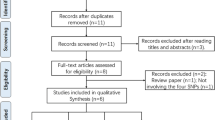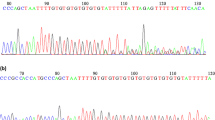Abstract
Purpose
To research the association between the single nucleotide polymorphisms (SNPs) of three spermatogenesis-related genes (USF1, GTF2A1L and OR2W3) and non-obstruction azoospermia (NOA).
Methods
We investigated 361 NOA cases and 368 controls from the Chinese Han population, and we used Sequenom iplex technology to analyze the candidate 9 SNPs from the USF1, GTF2A1L and OR2W3 genes.
Results
In this study, we found that the variant rs2516838 of USF1 was associated with NOA susceptibility (P = 0.020, OR = 1.436), and the haplotype TCG of the variants rs1556259, rs2516838, and rs2774276 of USF1 conferred an increased risk of NOA (P = 0.019, OR = 1.436). Furthermore, we found that the rs11204546 genotype of OR2W3 and the rs11677854 genotype of GTF2A1L were correlated with the FSH level in the patients (P = 0.004 and P = 0.018, respectively).
Conclusions
Our results provided a new insight into susceptibility of USF1 variant with male infertility. Clinically, the SNPs (rs11204546 of OR2W3 and rs11677854 of GTF2A1L ) might be additional valuable molecular predictive markers for assessing the treatment of NOA patients.
Similar content being viewed by others
References
De Kretser DM, Baker HW. Infertility in men: recent advances and continuing controversies. J Clin Endocrinol Metab. 1999;84(10):3443–50.
Rucker GB, Mielnik A, King P, Goldstein M, Schlegel PN. Preoperative screening for genetic abnormalities in men with nonobstructive azoospermia before testicular sperm extraction. J Urol. 1998;160(6 Pt 1):2068–71.
Cram DS, O’Bryan MK, de Kretser DM. Male infertility genetics—the future. J Androl. 2001;22(5):738–46.
Tüttelmann F, Rajpert-De Meyts E, Nieschlag E, Simoni M. Gene polymorphisms and male infertility–a meta-analysis and literature review. Reprod Biomed Online. 2007;15(6):643–58.
He XJ, Ruan J, Du WD, Chen G, Zhou Y, Xu S, et al. PRM1 variant rs35576928 (Arg > Ser) is associated with defective spermatogenesis in the Chinese Han population. Reprod Biomed Online. 2012;25(6):627–34.
Ruan J, He XJ, Du WD, Chen G, Zhou Y, Xu S, et al. Genetic variants in TEX15 gene conferred susceptibility to spermatogenic failure in the Chinese Han population. Reprod Sci. 2012;19(11):1190–96.
Jinam TA, Nakaoka H, Hosomichi K, Mitsunaga S, Okada H, Tanaka A, et al. HLA-DPB1*04:01 allele is associated with non-obstructive azoospermia in Japanese patients. Hum Genet. 2013;132(12):1405–11.
Tanaka H, Baba T. Gene expression in spermiogenesis. Cell Mol Life Sci. 2005;62(3):344–54.
Gregor PD, Sawadogo M, Roeder RG. The adenovirus major late transcription factor USF is a member of the helix-loop-helix group of regulatory proteins and binds to DNA as a dimer. Genes Dev. 1990;4(10):1730–40.
Sharpe RM, McKinnell C, Kivlin C, Fisher JS. Proliferation and functional maturation of Sertoli cells, and their relevance to disorders of testis function in adulthood. Reprod. 2003;125(6):769–84.
Wood MA, Walker WH. USF1/2 transcription factor DNA-binding activity is induced during rat Sertoli cell differentiation. Biol Reprod. 2009;80(1):24–33.
Wood MA, Mukherjee P, Toocheck CA, Walker WH. Upstream stimulatory factor induces Nr5a1 and Shbg gene expression during the onset of rat Sertoli cell differentiation. Biol Reprod. 2011;85(5):965–76.
Hou Y, Yuan J, Zhou X, Fu X, Cheng H, Zhou R. DNA demethylation and USF regulate the meiosis-specific expression of the mouse Miwi. PLoS Genet. 2012;8(5):e1002716.
Deng W, Lin H. miwi, a murine homolog of piwi, encodes a cytoplasmic protein essential for spermatogenesis. Dev Cell. 2002;2(6):819–30.
Kuramochi-Miyagawa S, Kimura T, Yomogida K, Kuroiwa A, Tadokoro Y, Fujita Y, et al. Two mouse piwi-related genes: miwi and mili. Mech Dev. 2001;108(1–2):121–33.
Cooper TG, Noonan E, von Eckardstein S, Auger J, Baker HW, Behre HM, et al. World health organization reference values for human semen characteristics. Hum Reprod Update. 2010;16(3):231–45.
Wu B, Lu NX, Xia YK, Gu AH, Lu CC, Wang W, et al. A frequent Y chromosome b2/b3 subdeletion shows strong association with male infertility in Han-Chinese population. Hum Reprod. 2007;22(4):1107–13.
Lu C, Zhang J, Li Y, Xia Y, Zhang F, Wu B, et al. The b2/b3 subdeletion shows higher risk of spermatogenic failure and higher frequency of complete AZFc deletion than the gr/gr subdeletion in a Chinese population. Hum Mol Genet. 2009;18(6):1122–30.
Hibi H, Ohori T, Yamada Y, Honda N, Asada Y. Probability of sperm recovery in non-obstructive azoospermic patients presenting with testes volume less than 10 ml/FSH level exceeding 20 mIU/ml. Arch Androl. 2005;51:225–31.
Barrett JC, Fry B, Maller J, Daly MJ. Haploview: analysis and visualization of LD and haplotype maps. Bioinforma. 2005;21(2):263–5.
Shi YY, He L. SHEsis, a powerful software platform for analyses of linkage disequilibrium, haplotype construction, and genetic association at polymorphism loci. Cell Res. 2005;15(2):97–8.
Dupont WD, Plummer Jr WD. Power and sample size calculations for studies involving linear regression. Control Clin Trials. 1998;19(6):589–601.
Viollet B, Lefrançois-Martinez AM, Henrion A, Kahn A, Raymondjean M, Martinez A. Immunochemical characterization and transacting properties of upstream stimulatory factor isoforms. J Biol Chem. 1996;271(3):1405–15.
Tourmen Y, Baris O, Dessen P, Jacques C, Malthièry Y, Reynier P. Structure and chromosomal distribution of human mitochondrial pseudogenes. Genom. 2002;80(1):71–7.
Lee PH, Shatkay H. F-SNP: computationally predicted functional SNPs for disease association studies. Nucleic Acids Res. 2008;36(Database issue):D820–4.
Venkatesh S, Kumar R, Deka D, Deecaraman M, Dada R. Analysis of sperm nuclear protein gene polymorphisms and DNA integrity in infertile men. Syst Biol Reprod Med. 2011;57:124–32.
Collings A, Höyssä S, Fan M, Kähönen M, Hutri-Kähönen N, Marniemi J, et al. Allelic variants of upstream transcription factor 1 associate with carotid artery intima-media thickness: the cardiovascular risk in young Finns study. Circ J. 2008;72(7):1158–64.
Kim M, Long TI, Arakawa K, Wang R, Yu MC, Laird PW. DNA methylation as a biomarker for cardiovascular disease risk. PLoS One. 2010;5(3):e9692.
Tan EK, Chan DK, Ng PW, Woo J, Teo YY, Tang K, et al. Effect of MDR1 haplotype on risk of Parkinson disease. Arch Neurol. 2005;62:460–4.
Ozer J, Moore PA, Lieberman PM. A testis-specific transcription factor IIA (TFIIAtau) stimulates TATA-binding protein-DNA binding and transcription activation. J Biol Chem. 2000;275(1):122–8.
Huang M, Wang H, Li J, Zhou Z, Du Y, Lin M, et al. Involvement of ALF in human spermatogenesis and male infertility. Int J Mol Med. 2006;17(4):599–604.
Aston KI, Krausz C, Laface I, Ruiz-Castané E, Carrell DT. Evaluation of 172 candidate polymorphisms for association with oligozoospermia or azoospermia in a large cohort of men of European descent. Hum Reprod. 2010;25(6):1383–97.
Plaseski T, Noveski P, Popeska Z, Efremov GD, Plaseska-Karanfilska D. Association study of single-nucleotide polymorphisms in FASLG, JMJDIA, LOC203413, TEX15, BRDT, OR2W3, INSR, and TAS2R38 genes with male infertility. J Androl. 2012;33(4):675–83.
Zitzmann M, Nordhoff V, von Schönfeld V, Nordsiek-Mengede A, Kliesch S, Schüring AN, et al. Elevated follicle-stimulating hormone levels and the chances for azoospermic men to become fathers after retrieval of elongated spermatids from cryopreserved testicular tissue. Fertil Steril. 2006;86:339–47.
Acknowledgments
We were grateful to the participants: the patients, the clinicians and the co-authors in this study.
Declaration of interests
The authors declared no potential conflicts of interest in terms of the research, authorship, and/or publication of this article. The authors alone were responsible for the content and writing of the paper.
Author information
Authors and Affiliations
Corresponding authors
Additional information
Capsule USF1 variant rs2516838 might confer risk to NOA.
Yan Zhang and Xiao-Jin He contributed equally to this manuscript.
Rights and permissions
About this article
Cite this article
Zhang, Y., He, XJ., Song, B. et al. Association of single nucleotide polymorphisms in the USF1, GTF2A1L and OR2W3 genes with non-obstructive azoospermia in the Chinese population. J Assist Reprod Genet 32, 95–101 (2015). https://doi.org/10.1007/s10815-014-0369-y
Received:
Accepted:
Published:
Issue Date:
DOI: https://doi.org/10.1007/s10815-014-0369-y




